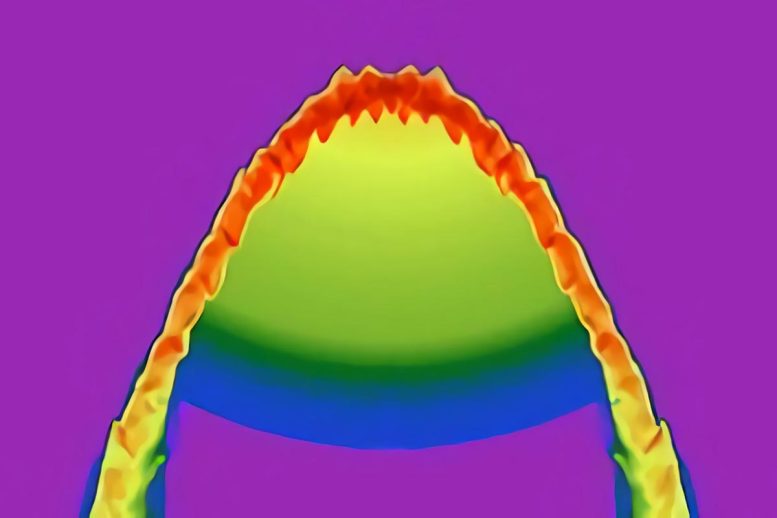
Log10 of the density distribution for model 40-200-0.1 after 2:00 x 104 yrs of evolution, plotted in the z = 0 plane. Contours show the color field plotted at 0.01, 0.025, 0.05, 0.075, and 0.1. The x-axis is horizontal and the y-axis is vertical. The downward propagating shock wave has compressed the target cloud core and is injecting shock front material through multiple Rayleigh-Taylor (RT) fingers. Image enhanced. Credit: Carnegie Institution for Science
A soon-to-be published study from scientists at Carnegie Institution for Science provides the first fully three-dimensional models for how a shock wave from a supernova explosion triggered the formation of our Solar System.
For decades it has been thought that a shock wave from a supernova explosion triggered the formation of our Solar System. According to this theory, the shock wave also injected material from the exploding star into a cloud of dust and gas, and the newly polluted cloud collapsed to form the Sun and its surrounding planets. New work from Carnegie’s Alan Boss and Sandra Keiser provides the first fully three-dimensional (3D) models for how this process could have happened. Their work will be published by The Astrophysical Journal Letters.
Traces of the supernova’s pollution can be found in meteorites in the form of short-lived radioactive isotopes, or SLRIs. SLRIs—versions of elements with the same number of protons, but a different number of neutrons—found in primitive meteorites decay on time scales of millions of years and turn into different, so-called daughter, elements. A million years may sound like a long time, but it is actually considered short when compared to other radioactive isotopes studied by geochemists and cosmochemists, which have half-lives measured in billions of years.
When scientists find the daughter elements distributed in telltale patterns in primitive meteorites, this means that the parent SLRIs had to be created just before the meteorites themselves were formed. This presents a timing problem, as the SLRIs must be formed in a supernova, injected into the presolar cloud, and trapped inside the meteoritic precursors, all in less than a million years.
The telltale patterns prove that the relevant daughter elements were not the ones that were injected. This is because the abundances of these daughters in different mineral phases in the meteorite are correlated with the abundance of a stable isotope of the parent element. Different elements have different chemical behaviors during the formation of these first solids, and the fact that the daughter elements correlate with the parent elements means that those daughters had to be derived from the decay of unstable parent elements after those solids were crystallized.
One of these SLRIs, iron-60, is only created in significant amounts by nuclear reactions in massive stars. The iron-60 must have come from a supernova, or from a giant star called an AGB star. Boss and Keiser’s previous modeling showed that it was likely that a supernova triggered our Solar System’s formation, as AGB star shocks are too thick to inject the iron-60 into the cloud. Supernova shocks are hundreds of times thinner, leading to more efficient injection.
Now Boss and Keiser have extended those models to 3D, so they can see the shock wave striking the gas cloud, compressing it, and forming a parabolic shock front that envelopes the cloud, creating finger-like indentations in the cloud’s surface. The fingers inject the SLRI pollution from the supernova. Less than 0.1 million years later, the cloud collapses and forms the core of the protostar that became the Sun and its surrounding planets. The 3D models show that only one or two fingers are likely to have caused the SLRI pollution found in primitive meteorites.
“The evidence leads us to believe that a supernova was indeed the culprit,” said Boss. However, more detective work needs to be done: Boss and Keiser still need to find the combination of cloud and shock wave parameters that will line up perfectly with observations of exploding supernovae.
Reference: “Supernova-Triggered Molecular Cloud Core Collapse and the Rayleigh–Taylor Fingers That Polluted the Solar Nebula” by Alan P. Boss and Sandra A. Keiser, 9 August 2012, The Astrophysical Journal Letters.
DOI: 10.1088/2041-8205/756/1/L9
This research was supported by NASA. The software used in this work was, in part, developed by the DOE-supported ASC/Alliances Center for Astrophysical Thermonuclear Flashes a the University of Chicago





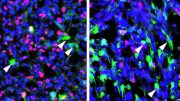
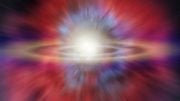
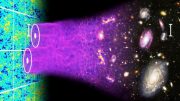
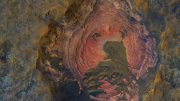
Be the first to comment on "3D Models Confirm Supernova’s Role in the Formation of Our Solar System"